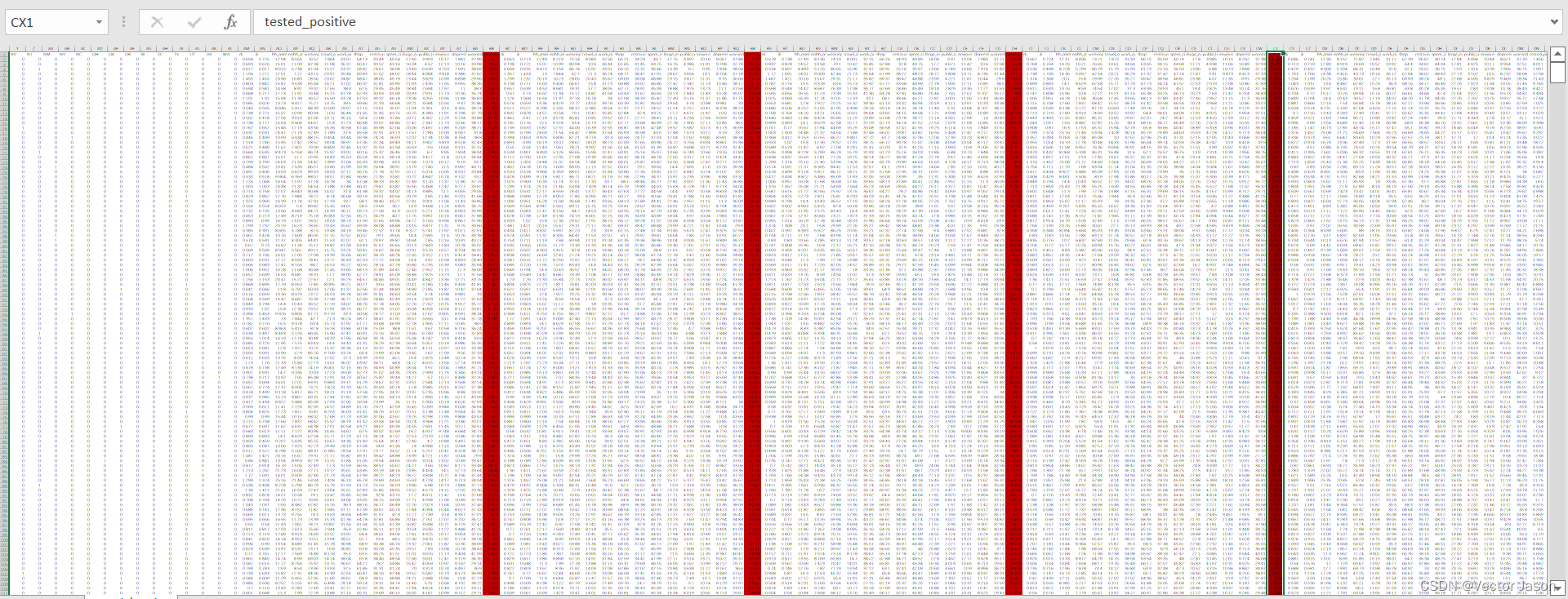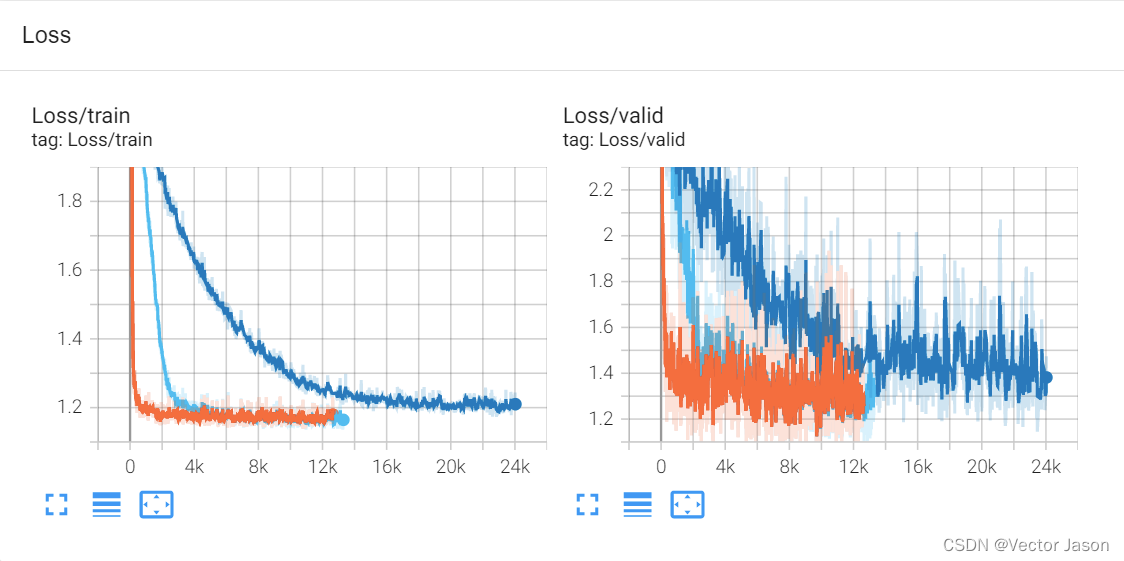目录
一. 开题说明:
本人在完成HW1的过程中,发现存在以下困难:
1. 信息获取相对麻烦,不易于寻找相关资料
2. 可提供的有用信息比较零散,导致不能马上检索出关键
3. 部分高质量代码因博主个人收取费用,致使开源学习受限
鉴于以上,在此进行开源分享,希望能更好地帮助大家同时加深自己的印象。以下是提交结果,其中得分分别来自于Private Score和Public Score(已过Strong Baseline)
二. 梗概:
通过Sample Code的运行,在Kaggle平台上可取得在Private和Public Score上分别为1.91281,1.89565的分数,本文在Sample Code的基础上,更进了Feature Selection,DNN,Optimizer以及learning rate,最终取得Private和Public Score上分别为1.08889,1.02013的分数。
三. 问题背景:
Based on the survey results of the past 5 days in specific states of the United States, the percentage of new positive cases on the fifth day is predicted. Through this training, we should achieve the following objectives:
- Solve a regression problem with deep neural networks (DNN).
- Understand basic DNN training tips.
- Familiarize yourself with PyTorch.
四. 模型建立:
1. 数据下载
P.S. 数据集能够通过pip指令下载,也能够从Kaggle平台上直接下载:
!gdown --id '1kLSW_-cW2Huj7bh84YTdimGBOJaODiOS' --output covid.train.csv
!gdown --id '1iiI5qROrAhZn-o4FPqsE97bMzDEFvIdg' --output covid.test.csv
2. 导入必要的包
# Numerical Operations
import math
import numpy as np
# Reading/Writing Data
import pandas as pd
import os
import csv
# For Progress Bar
from tqdm import tqdm
# Pytorch
import torch
import torch.nn as nn
from torch.utils.data import Dataset, DataLoader, random_split
# For plotting learning curve
from torch.utils.tensorboard import SummaryWriter
3. 定义函数
def same_seed(seed):
'''Fixes random number generator seeds for reproducibility.'''
torch.backends.cudnn.deterministic = True
torch.backends.cudnn.benchmark = False
np.random.seed(seed)
torch.manual_seed(seed)
if torch.cuda.is_available():
torch.cuda.manual_seed_all(seed)
def train_valid_split(data_set, valid_ratio, seed):
'''Split provided training data into training set and validation set'''
valid_set_size = int(valid_ratio * len(data_set))
train_set_size = len(data_set) - valid_set_size
train_set, valid_set = random_split(data_set, [train_set_size, valid_set_size], generator=torch.Generator().manual_seed(seed))
return np.array(train_set), np.array(valid_set)
def predict(test_loader, model, device):
model.eval() # Set your model to evaluation mode.
preds = []
for x in tqdm(test_loader):
x = x.to(device)
with torch.no_grad():
pred = model(x)
preds.append(pred.detach().cpu())
preds = torch.cat(preds, dim=0).numpy()
return preds
def trainer(train_loader, valid_loader, model, config, device):
criterion = nn.MSELoss(reduction='mean') # Define your loss function, do not modify this.
# Define your optimization algorithm.
# TODO: Please check https://pytorch.org/docs/stable/optim.html to get more available algorithms.
# TODO: L2 regularization (optimizer(weight decay...) or implement by your self).
optimizer = torch.optim.Adam(model.parameters(), lr=config['learning_rate'])
writer = SummaryWriter() # Writer of tensoboard.
if not os.path.isdir('./models'):
os.mkdir('./models') # Create directory of saving models.
n_epochs, best_loss, step, early_stop_count = config['n_epochs'], math.inf, 0, 0
for epoch in range(n_epochs):
model.train() # Set your model to train mode.
loss_record = []
# tqdm is a package to visualize your training progress.
train_pbar = tqdm(train_loader, position=0, leave=True)
for x, y in train_pbar:
optimizer.zero_grad() # Set gradient to zero.
x, y = x.to(device), y.to(device) # Move your data to device.
pred = model(x)
loss = criterion(pred, y)
loss.backward() # Compute gradient(backpropagation).
optimizer.step() # Update parameters.
step += 1
loss_record.append(loss.detach().item())
# Display current epoch number and loss on tqdm progress bar.
train_pbar.set_description(f'Epoch [{epoch+1}/{n_epochs}]')
train_pbar.set_postfix({'loss': loss.detach().item()})
mean_train_loss = sum(loss_record)/len(loss_record)
writer.add_scalar('Loss/train', mean_train_loss, step)
model.eval() # Set your model to evaluation mode.
loss_record = []
for x, y in valid_loader:
x, y = x.to(device), y.to(device)
with torch.no_grad():
pred = model(x)
loss = criterion(pred, y)
loss_record.append(loss.item())
mean_valid_loss = sum(loss_record)/len(loss_record)
print(f'Epoch [{epoch+1}/{n_epochs}]: Train loss: {mean_train_loss:.4f}, Valid loss: {mean_valid_loss:.4f}')
writer.add_scalar('Loss/valid', mean_valid_loss, step)
if mean_valid_loss < best_loss:
best_loss = mean_valid_loss
torch.save(model.state_dict(), config['save_path']) # Save your best model
print('Saving model with loss {:.3f}...'.format(best_loss))
early_stop_count = 0
else:
early_stop_count += 1
if early_stop_count >= config['early_stop']:
print('\nModel is not improving, so we halt the training session.')
return4. 定义类(Dataset以及DNN)
class COVID19Dataset(Dataset):
'''
x: Features.
y: Targets, if none, do prediction.
'''
def __init__(self, x, y=None):
if y is None:
self.y = y
else:
self.y = torch.FloatTensor(y)
self.x = torch.FloatTensor(x)
def __getitem__(self, idx):
if self.y is None:
return self.x[idx]
else:
return self.x[idx], self.y[idx]
def __len__(self):
return len(self.x)
class My_Model(nn.Module):
def __init__(self, input_dim):
super(My_Model, self).__init__()
# TODO: modify model's structure, be aware of dimensions.
self.layers = nn.Sequential(
nn.Linear(input_dim, 64),
nn.LeakyReLU(0.1),
nn.Linear(64, 32),
nn.LeakyReLU(0.1),
nn.Linear(32, 16),
nn.LeakyReLU(0.1),
nn.Linear(16, 8),
nn.LeakyReLU(0.1),
nn.Linear(8, 1),
)
def forward(self, x):
x = self.layers(x)
#x = nn.functional.dropout(x,p=0.01,training=self.training)
x = x.squeeze(1) # (B, 1) -> (B)
return x
from google.colab import drive
drive.mount('/content/drive')5. 特征选择
由于在测试集中需预测第五天的tested_postive,因此我选用了前四天的tested_positive作为feat_idx以增强数据之间的相关性。值得注意的是,在处理csv文件时需去除第一列(id对问题的解决无实际性意义)。
def select_feat(train_data, valid_data, test_data, select_all=True):
'''Selects useful features to perform regression'''
y_train, y_valid = train_data[:,-1], valid_data[:,-1]
raw_x_train, raw_x_valid, raw_x_test = train_data[:,:-1], valid_data[:,:-1], test_data
if select_all:
feat_idx = list(range(raw_x_train.shape[1]))
else:
feat_idx = [53, 69, 85, 101] # TODO: Select suitable feature columns.
return raw_x_train[:,feat_idx], raw_x_valid[:,feat_idx], raw_x_test[:,feat_idx], y_train, y_valid训练集covid.train.csv大致情况如下:

6. 定义超参数
device = 'cuda' if torch.cuda.is_available() else 'cpu'
config = {
'seed': 5201314, # Your seed number, you can pick your lucky number. :)
'select_all': False, # Whether to use all features.
'valid_ratio': 0.2, # validation_size = train_size * valid_ratio
'n_epochs': 3000, # Number of epochs.
'batch_size': 256,
'learning_rate': 1e-4,
'early_stop': 400, # If model has not improved for this many consecutive epochs, stop training.
'save_path': './models/model.ckpt' # Your model will be saved here.
}7. 定义DataLoader
从文件中读取数据并设置培训、验证和测试集。
# Set seed for reproducibility
same_seed(config['seed'])
# train_data size: 2699 x 118 (id + 37 states + 16 features x 5 days)
# test_data size: 1078 x 117 (without last day's positive rate)
train_data, test_data = pd.read_csv('./covid.train.csv').values, pd.read_csv('./covid.test.csv').values
train_data, valid_data = train_valid_split(train_data, config['valid_ratio'], config['seed'])
# Print out the data size.
print(f"""train_data size: {train_data.shape}
valid_data size: {valid_data.shape}
test_data size: {test_data.shape}""")
# Select features
x_train, x_valid, x_test, y_train, y_valid = select_feat(train_data, valid_data, test_data, config['select_all'])
# Print out the number of features.
print(f'number of features: {x_train.shape[1]}')
train_dataset, valid_dataset, test_dataset = COVID19Dataset(x_train, y_train), \
COVID19Dataset(x_valid, y_valid), \
COVID19Dataset(x_test)
# Pytorch data loader loads pytorch dataset into batches.
train_loader = DataLoader(train_dataset, batch_size=config['batch_size'], shuffle=True, pin_memory=True)
valid_loader = DataLoader(valid_dataset, batch_size=config['batch_size'], shuffle=True, pin_memory=True)
test_loader = DataLoader(test_dataset, batch_size=config['batch_size'], shuffle=False, pin_memory=True)8. 训练与预测
# Start Training !!!
model = My_Model(input_dim=x_train.shape[1]).to(device) # put your model and data on the same computation device.
trainer(train_loader, valid_loader, model, config, device)
# Start Predicting !!!
def save_pred(preds, file):
''' Save predictions to specified file '''
with open(file, 'w') as fp:
writer = csv.writer(fp)
writer.writerow(['id', 'tested_positive'])
for i, p in enumerate(preds):
writer.writerow([i, p])
model = My_Model(input_dim=x_train.shape[1]).to(device)
model.load_state_dict(torch.load(config['save_path']))
preds = predict(test_loader, model, device)
save_pred(preds, 'pred.csv') 五. 可视化分析
在深度学习框架中,有很多可视化的工具,其中,Tensorboard是一个工具,可以让您可视化训练进度。运行该配件时,需利用以下指令:
%reload_ext tensorboard
%tensorboard --logdir=./runs/ 训练过程Loss在Train和Valid的下降过程如下:
此外,可以在board上滑动鼠标进行数值的更进一步分析:

六. 优缺点分析与改进建议
优点:
1. 本文从相关性出发针对性地选取了前四天的tested_positive,同时利用优化后的全连接层完成了回归预测。
2. 对优化器进行了改进,利用Adam使Loss下降更加平稳,同时稍提高learning rate以增加Loss的收敛速度
缺点:
1. 由于能力受限,无法对整个数据集中的所有指标进行相关性分析
2. learning rate不能随着学习过程的变化进行动态更替,导致训练后期并不能收敛到一个较低的值,而是进行反复地上下波动
3. 未考虑是否存在过拟合情况
改进建议:
1. 查阅文献,可采用余弦退火的技巧对learning rate进行动态更新
2. 可利用sklearn中的特征选择方法对Feature Selection进行更改,同时可对各个指标进行归一化
3. 在DNN模型定义中加入L2正则化,Dropout等方法防止模型过拟合























 被折叠的 条评论
为什么被折叠?
被折叠的 条评论
为什么被折叠?








